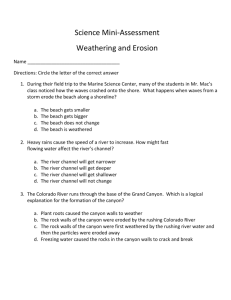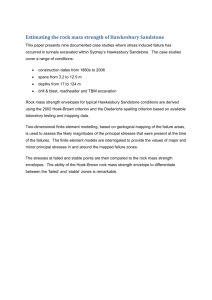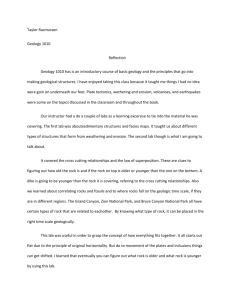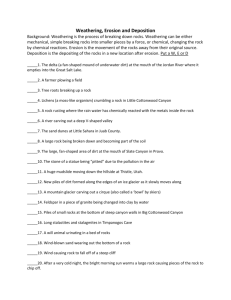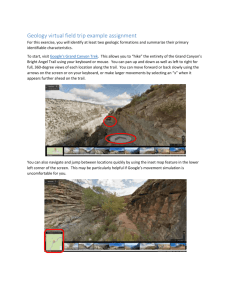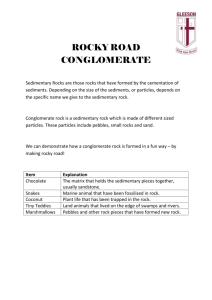Interpreting the Geologic History of Canyon de Chelly Background
advertisement
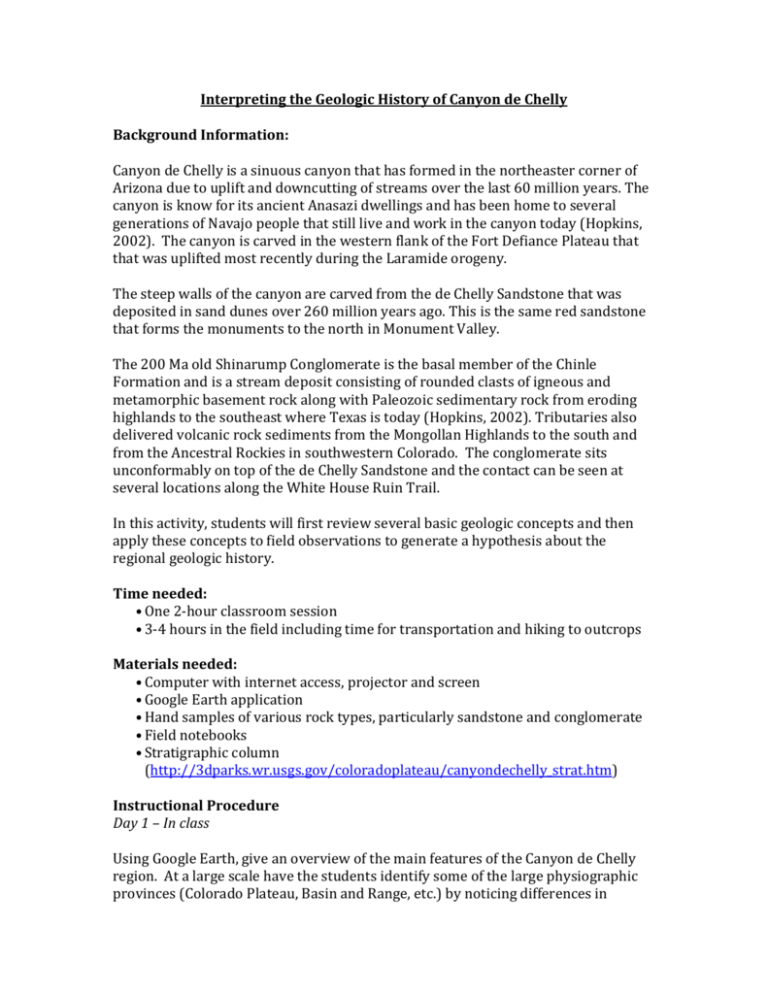
Interpreting the Geologic History of Canyon de Chelly Background Information: Canyon de Chelly is a sinuous canyon that has formed in the northeaster corner of Arizona due to uplift and downcutting of streams over the last 60 million years. The canyon is know for its ancient Anasazi dwellings and has been home to several generations of Navajo people that still live and work in the canyon today (Hopkins, 2002). The canyon is carved in the western flank of the Fort Defiance Plateau that that was uplifted most recently during the Laramide orogeny. The steep walls of the canyon are carved from the de Chelly Sandstone that was deposited in sand dunes over 260 million years ago. This is the same red sandstone that forms the monuments to the north in Monument Valley. The 200 Ma old Shinarump Conglomerate is the basal member of the Chinle Formation and is a stream deposit consisting of rounded clasts of igneous and metamorphic basement rock along with Paleozoic sedimentary rock from eroding highlands to the southeast where Texas is today (Hopkins, 2002). Tributaries also delivered volcanic rock sediments from the Mongollan Highlands to the south and from the Ancestral Rockies in southwestern Colorado. The conglomerate sits unconformably on top of the de Chelly Sandstone and the contact can be seen at several locations along the White House Ruin Trail. In this activity, students will first review several basic geologic concepts and then apply these concepts to field observations to generate a hypothesis about the regional geologic history. Time needed: • One 2-hour classroom session • 3-4 hours in the field including time for transportation and hiking to outcrops Materials needed: • Computer with internet access, projector and screen • Google Earth application • Hand samples of various rock types, particularly sandstone and conglomerate • Field notebooks • Stratigraphic column (http://3dparks.wr.usgs.gov/coloradoplateau/canyondechelly_strat.htm) Instructional Procedure Day 1 – In class Using Google Earth, give an overview of the main features of the Canyon de Chelly region. At a large scale have the students identify some of the large physiographic provinces (Colorado Plateau, Basin and Range, etc.) by noticing differences in topography and vegetation. At a medium scale, the Defiance Plateau and Shiprock are clearly visible. Zoom in even more for a view of Canyon de Chelly and its numerous tributaries. Discuss with the students how they think the various features were formed using concepts of plate tectonics, weathering, erosion, etc. Zoom in even more to get a view of the rocks at Canyon de Chelly. Note that you can see the dark maroon caprock of the Shinarump Conglomerate and the underlying lighter colored de Chelly sandstone. North-south running fractures are also visible in the rocks. Review the basic rock types and how they are formed. Discuss how sandstones, conglomerates, etc. can be deposited in a variety of environments. If you students are new to geology it will helpful to have some hand samples as well. Review the basic geologic principles of original horizontality, superposition and cross-cutting relationships. Day 2 –Canyon de Chelly White House Ruin Trail 1. Prior to heading down the trail, instruct students to make observations about their location, the terrain, the color, type and tilt of the rocks, and anything else that they might notice. Stop at the first outcrop of well-exposed rock (the Shinarump Conglomerate) and discuss as a group the features that they observe. Note composition, color, grain size, sorting, cross-bedding, etc. Have them make a sketch of what they observe. Continue down the trail, making observations at various points along the way. At the second switchback, the trail begins to wind down through the de Chelly Sandstone. Have the student take note of the contrast of the two rock types. Have them make detailed notes of the sandstone in the same manner they did with the conglomerate. Instruct students to make a sketch of the rocks and note the nature of the contact (smooth, irregular, gradual, sharp, etc.). About 50 yards further down the trail is a prominent channel cut and fill. Have the students speculate on the nature of its formation, again, making a sketch of their observations. Proceed a bit further down the trail, just before the next bench, to a near vertical contact between the songlomerate and the sandstone. This is an ancient narrow slot canyon where the Shinarump gravels filled in a deep channel in the de Chelly sandstone. Again, have the students make observations and commit to naming the rock types in each unit. 2. Split the students into small groups and have then come up with (and write down) hypotheses that explain: • Which rock unit is older. • How each rock unit formed. • What the rock record at this location tells us about Earth history and changing environmental conditions. Make sure that students know to backup their hypotheses with evidence. 3. Bring the groups back together to share their hypothesis. Discuss the merits of each, reminding everyone that several scenarios can often produce similar results in the rock record. 4. Hand out the stratigraphic columns and give students a few minutes to discuss how their hypothesis does or does not fit into the big picture of events. Have students identify the formation names of their two units (de Chelly Sandstone and Shinarump Conglomerate). 5. Go over the geologic history of area, make sure to emphasize that they are sitting at the contact point of an unconformity spanning 60 million years. Assessment Use the written hypothesis statements to evaluate if students are grasping main concepts.
